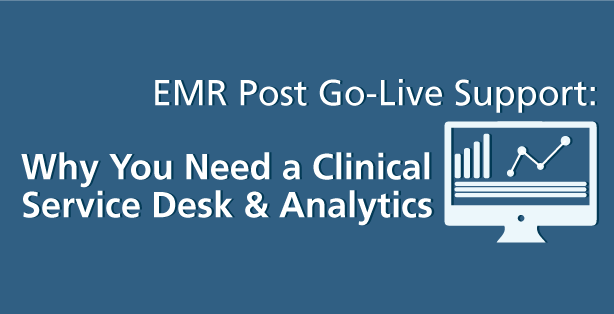
“There simply aren’t enough hours in the day.” This cliché describes the plight of many organizations. Healthcare facilities are no exception, especially when they have just gone live with a new EMR.
When supported by analytics, an established clinical service desk becomes a vital element for supporting your new EMR post go-live.
In this post, we discuss how to use people and processes to support your EMR as efficiently and effectively as possible.
1) Clinical Service Desk
One of the main problems that that can arise following an EMR Go-Live is inefficiency within your service desk. It is unreasonable to expect your service desk to be knowledgeable in all of the different modules that a given EMR has to offer. This leads to the service desk collecting as much information as they can about an issue and then relaying the problem to tier 2 analysts who decide what to do with the problem. If your service desk doesn’t have the relevant knowledge and experience, there will be several different instances of back and forth dialogue between the service desk and tier 2 analyst to diagnose a single issue. This is clearly a very inefficient way to come to a solution.
This is where the advantage of an EMR Clinical Service Desk comes into play. It will be staffed with EMR consultants, who will be able to immediately correct issues as they arise. If a request needs the attention of a specialist, the EMR tier 1 analyst will know how to efficiently escalate and communicate an issue to a tier 2 analyst, thus the process is expedited and immediately able to be remedied. In some clinical service desk models, an end user can call the help desk line and “press 2” to dial directly into the clinical serve desk support analysts.

2) EMR Support: The Key Role of Analytics
After you have correctly and properly allocated your resources, you will need to look at how you’re utilizing your processes. Here are some questions to ask:
- Is time being spent equally across your EMR support model?
- Do you have visibility that shows everything at a departmental level?
- Do you have visibility into the EMR module team level?
- Can you look at spending more time on operational support than project management?
- How does that compare to ambulatory? How does it compare to inpatient etc.?
- Can you get down to the individual analyst level?
It’s all about getting the full view of the support. Analytics will give you this visibility. What tools are you using to effectively collect, and act upon, this information? HCI has developed a proprietary EMR Service Desk analytics tool to help you maximize the value of your new EMR. (Brandon – Service Desk CTA here).
Using analytics can greatly benefit your organization post Go-Live, due to the fact that it can help provide a full view of support. By utilizing a clinical service desk, one which is supported by analytics, costs associated with inefficiency and improper use of resources and process can be cut down, as well as the wasted time that goes along with them. The clinical service desk, when utilized properly, has the potential to make the number of hours in a day seem just right.